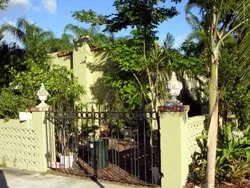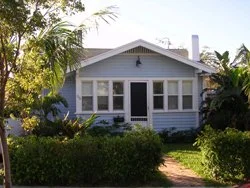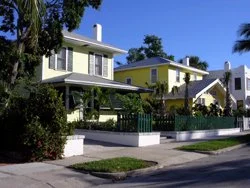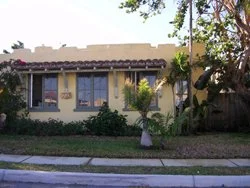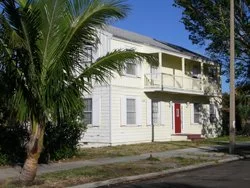
One of the city's oldest neighborhoods still intact, Grandview Heights was built as an extension of Palm Beach Heights from around 1910 to 1925. The neighborhood has one of the city's best collections of early craftsman-style bungalows, as well as some modest, Mediterranean revival-style homes.
Spanish Colonial Revival (Mediterranean Revival)
The National Register of Historic Places prefers the use of the term Mission/Spanish Colonial Revival to refer to a style more commonly known as the Mediterranean Revival. This style is found most frequently in states which have a Spanish Colonial heritage, but its use gained national popularity. It was the most popular style for residential architecture in Florida during the 1920s and was also used in hotels, commercial buildings, railroad stations, and schools. The style incorporated architectural elements derived from the area around the Mediterranean Sea, especially Italy, and Spain. Various aspects of the style have been categorized as Spanish Colonial or Mission Revival, but the result is a wide array of eclectic buildings. The style was popularized by the Pan-American Exhibition held in San Diego in 1915.
Bungalow
Although it could be argued that Bungalow refers to a building type, rather than a style, the style guides published by the National Trust for Historic Preservation identify the bungalow as a style. The term bungalow was popularized in the early twentieth century to describe a cottage-like dwelling, informal in plan, elevation, and detail. It answered the need for simple, comfortable, economic residences. The popularity of the bungalow spread across the country. Many were built from mail orders, and house plan catalogs. Sears and Roebuck offered a variety of bungalow designs and would ship complete plans and the necessary building materials. Other companies, such as the Gordon-Van Tine Company of Davenport, Iowa, shipped prefabricated bungalows.
American Four-Square
The American Four-Square was a very popular two-story house type throughout the country between the years 1900 to 1925. This common vernacular form was first named and described in an Old House Journal article in 1982. The American Four-Square provided an economical and practical home-type that avoided the profusion of ornament associated with the Victorian period. The cubic shape of the house provided space for four rooms on each floor and a central or side stairway. The house was typically covered by a low-hipped roof, often pierced by dormers, and with broad eaves. Exposed rafter ends frequently extended below the eave. Characteristically, the American Four-square has a porch that extends across the width of the façade. The porch roof is supported by boxed-in posts or simple columns.
Architecture in Grandview Heights
Art Deco
The 1925 Paris Exposition des Artes Decoratif is generally credited as the inspiration for expressing architectural modernity through the Art Deco style. The verticality of buildings was emphasized in the late 1920s and 1930s by rectilinear, geometric surface ornamentation. Wall surfaces were smooth and usually of stucco. Other characteristics of the Art Deco style are: towers or other vertical projections above the roof line, symmetrical facades, and a unique form of ornamentation consisting of zig-zags, chevrons, sunbursts, spirals, and/or stylized plant and animal motifs, abstract arabesques, elongated ovals and octagonal panels.
Mission Revival
The Mission Revival style is a subtype of the Spanish Colonial Revival style. It derives its name from the California masonry tradition in architecture established by the Franciscan missionaries. The style became popular when it was used for the California Building at the Columbian Exposition in Chicago in 1893, and its use was widespread by 1915. The style is characterized by an overall simplicity, arched openings, large expanses of unadorned stucco surfaces, the use of stepped or curvilinear parapets, quatrefoil windows, porches or covered entryways, and minimal decorative detailing. Exterior walls are stucco and barrel tile roofing is common. An even more simplified version of the Mission Revival style became popular in the 1930s.
Monterey
The Monterey style originated in California and was especially popular between 1930 and 1950. It was a fusion of revival styles derived from New England, the South, and the Southwest. The resulting designs were two-story residences that exhibited Spanish eclectic and Colonial Revival characteristics. The distinctive features of the style include a low-pitched, side-facing gable roof and a full-length, second story balcony. The balcony is usually cantilevered and covered by the principal roof. Decorative detailing is often confined to the balcony balustrade. The first and second stories often feature different building materials. Typically, the first floor is brick or stucco, with the second floor finished in clapboard. Exterior end chimneys are common
Dutch Colonial Revival
The Dutch Colonial style enjoyed a revival during the first three decades of the 20th century as the country looked back with nostalgia to its colonial past. The gambrel roof is the distinguishing feature.
If your home is one of these house types and would like to be showcased on our website, please email us pictures at
grandviewheightswpb@gmail.com

